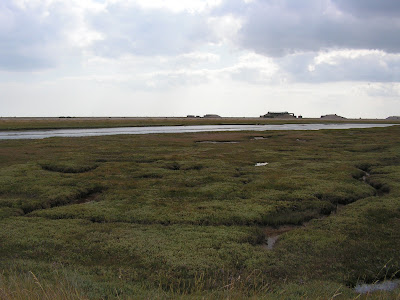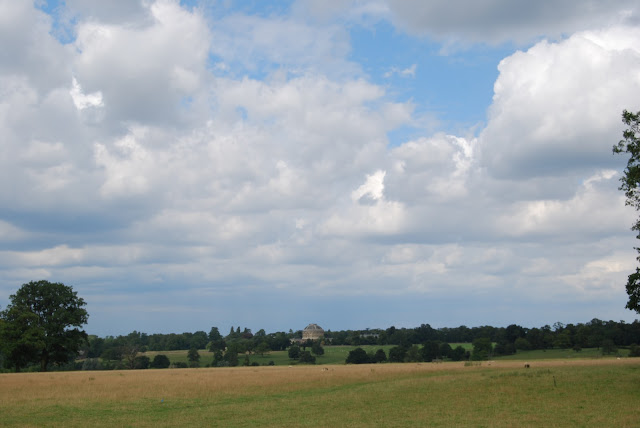First off - don't panic, I haven't done this for fun (it's part of a course), but feel like sharing it as it's what I attempt (sometimes forlornly) to do now...
Before
discussing the role of mathematics in today’s world, let us briefly look at its
historical and cultural development. The needs of mankind over time are directly
correlated to the development of mathematics. From helping develop concepts of
time, dates and distance, to early trade and commerce, mathematics has been a
fundamental necessity. The first known example of mathematical symbols was
found in Africa on a bone which dates from around 35,000 years ago, and
therefore pre-dates the written language by thousands of years (Learner.org,
2011). It has a series of tally marks which may represent simple counting. Another
bone, now known as the ‘Ishango bone’, dated to 25,000 years ago, has groups of
markings, some of which represent prime numbers. The precise use for this bone
is still being debated but it was possibly used as a lunar calendar, and proves
that mathematical concepts, and possibly prime numbers, were being used as
early as 23,000 BC. The early twentieth century saw the astonishing underwater
discovery of the remains of a small bronze analogue computer, built by the
Greeks and dated to the year 87 BC, and known as the Antikythera Mechanism. It
is thought to have been used to calculate the movements of stars and planets in
astronomy, and to make astronomical calculations and predictions. Technological artefacts of similar complexity and
workmanship did not reappear until the 14th century.
Trade
and commerce in ancient times necessitated the need for arithmetic in order to
count goods – to record what was sold, bought or bartered. The first recorded
teaching of addition, subtraction, multiplication and division was by the
merchants of Venice so that they could expand their commercial influence
(Swetz, 1987). The surveying of land would naturally have led to mathematical
concepts of geometry and trigonometry, being practised thousands of years ago,
whilst circles and their properties would have been studied during the
construction of arenas and water tanks. This led to the discovery of the
properties of shapes and solids, formulae for area and volume and to the
classification of curves and shapes. Early algebraic problems could have been
practical ones such as calculating logistical needs, allocating resources and
also working out areas and volumes.
In
the past, it was not seen as important to have a numerate society as a whole.
Maths was the domain of mathematicians, and the subject, for most, gladly left
behind at school (or never learned at all). Mathematics as a common demand and
need, however, can be seen as a product of industrialisation, and particularly,
post-war globalisation. The fast development of technology, the proliferation
of computers and the development of the internet over the last twenty years have
led to a huge abundance of data: information that needs to be read, understood
and interpreted by a large proportion of the population.
In today’s world, good levels of basic numeracy (and
literacy) are particularly important for any nation that expects to compete in
the global economy. In the last thirty years this has led to a drive to improve
the levels of everyday numeracy so that the largest possible number of people
can function in society and be able to do things such as plan journeys and read
and write timetables, and read and understand the meanings of graphs,
statistics, data, percentages, finance, tax and insurance. In Britain, practical
numeracy skills were described by the Cockcroft Report (‘Mathematics Counts’,1986)
as those mathematical skills that ‘enable an individual to cope with the
practical demands of everyday life.’ It was becoming increasingly apparent that
the levels of basic mathematics at home (and in many other developed nations)
were simply not good enough if Britain was to compete in an ever-changing,
high-tech, ‘global village’ world. This report was commissioned because of ‘the
apparent lack of basic computation skills in many children, the increasing
mathematical demands made on adults, the lack of qualified maths teachers, the
multiplicity of syllabuses for old, new and mixed maths, the lack of
communication between further and higher education, employers and schools about
each group's needs and viewpoints…'
(Cockcroft Report, 1986).
The outcome of this report and other similar commissions
such as the Moser Report (1998) led to National Strategy for Adult Basic Skills
and the development of the National Core Curriculum and such qualifications as
Key and Functional Skills – these included mathematics courses that addressed
the real, everyday world.
The
Moser report also acknowledged that their recommendations, designed to improve
basic levels of numeracy, were easier said than done (Lifelong Learning, 2000):
‘There are inevitably problems of motivation among prospective learners. This
is partly because people with difficulties are often understandably reluctant to
acknowledge, or are unaware, that they have a problem; or that it matters or
indeed that there are ways of tackling it. Moreover, few employers take a
constructive approach to advancing basic skills in their workforce.’
Even
though much work has been done and thousands of people have improved their
numeracy skills over the past two decades because of a national strategy,
mathematics is still a taboo area for many people. Low levels of numeracy can
be exacerbated by poor public perceptions of mathematics. Both employers and
employees can be very insecure – an insecurity often brought about by poor
experiences of maths lessons at school. There are plenty of well-educated and
well-paid people out there who may be virtually innumerate, or who avoid
careers or tasks that may involve mathematics, however basic. So the push to
improve levels of numeracy has also had to improve people’s confidence in it,
so that they can make effective use of whatever mathematics they have already
learned, and so that they can then appropriately use numeracy to whatever level
that suits their circumstances. A related
finding is the perception that numeracy is not as relevant as literacy – and this
view is sometimes held not only by learners but also by some vocational
teaching staff. Even some managers and employers are reportedly not as
concerned about numeracy as they are about literacy and communication skills
(QIA Skills for Life Improvement Programme – Numeracy Overview, 2008).
Therefore all the barriers experienced by would-be learners of numeracy may be
the same for teachers – fear, anxiety, low priority, perceived irrelevance,
lack of time and commitment and negative school experience.
It is again worth pointing out here that learner motivation can be aided
by addressing the issue of poor public perception and by linking mathematics to
life and work in general. If the maths involved is useful in a practical way
and can be seen to help job-seeking opportunities, then it is far more likely
to be seen to be beneficial and be tackled in a positive way.
It is also quite clear from research that innumeracy can
be closely linked to other social issues. To illustrate this point The Moser
Report used this example: ‘Some 60% of people in prison suffer from functional
illiteracy and/or innumeracy.’ (Lifelong Learning, 2000). The Programme for
International Student Assessment Report of 2006 (PISA Report) stated that:
‘With the growing role of science, mathematics and technology in modern life,
the objectives of personal fulfilment, employment and full participation in
society increasingly require that all adults… should be mathematically,
scientifically and technologically literate.’
The point is clear. Being confident with basic
mathematical concepts may not only improve chances of employability, but also
aid personal development. A better educated, numerate person may also be a more
confident, rounded, contented person. Boris Johnson, the Mayor of London,
recently claimed that a ‘systemic fight against educational underachievement
can tackle the social exclusion that lay behind last summer's riots’ (The Guardian, 23rd March
2012). The implication is that if people feel socially excluded, then they will
feel that they have no future in society. Achieving at maths (and English), at
any level and at any age, can help a person believe that they do have a future,
that this may help them gain employment and find a place in that society.
Johnson went on to directly link poor basic skills to
social unrest, and therefore by proxy to low self-esteem, by arguing that tackling
illiteracy and innumeracy was the best antidote to the ‘nihilism’ and
‘exclusion’ revealed by the riots. The challenge is therefore to encourage
learners to realise that learning and becoming adept at practical numeracy can
help their personal development for a number of reasons, and not just economic
ones. This is why The PISA Report (2006) states that ‘deficiencies among lower-performing
students in mathematics can have negative consequences for individuals’
labour-market and earnings prospects and for their capacity to participate
fully in society.’
Furthermore, learning Functional Skills mathematics
requires a problem solving approach, and the skills required for problem
solving are in turn more than a vehicle for teaching and reinforcing
mathematical knowledge and helping to meet everyday challenges. They are ‘skills
which can enhance logical reasoning. Individuals can no longer function
optimally in society by just knowing the rules to follow to obtain a correct
answer. They also need to be able to decide through a process of logical
deduction what algorithm, if any, a situation requires, and sometimes need to
be able to develop their own rules in a situation where an algorithm cannot be
directly applied. For these reasons problem solving can be developed as a
valuable skill in itself, a way of thinking rather than just as the means to an
end of finding the correct answer (NCTM website).
This gives teachers of mathematics a social
responsibility and the task of encouraging their learners to realise the wider
implications and to help them to realise their own potential. This may involve
serving a wide range of student abilities and include those who are motivated
and who may perform well, to those who are apathetic and indifferent to mathematics and
who may be most in need. With the help of governmental public policies (as
already mentioned above), appropriate institutional support and good
professional practice teachers can contribute to providing equal opportunities,
equitable learning and personal development outcomes for all students.
Bibliography
Bartlett, S. & Burton, D. (2003) Educational
Studies: Essential Issues, London: Sage Publications Ltd
Curzon, L.B. (1997) Teaching in Further
Education, an Outline of Principles and Practice, 5th Edition,
London: Continuum Education
|
|
Frank J. Swetz, Capitalism
and Arithmetic. Peru, Illinois: Open Court, 1987.
|
|
|
Official
Publications
PISA Report, 2006: Science
Competencies For Tomorrow’s World. Volume 1: Analysis. OECD Publishing.
Available at:
www.oecd.org/pages/0,3417,en_32252351_32236191_1_1_1_1_1,00.html
(accessed 27-3-12)
QIA Skills for Life
Improvement Programme, 2008 – Numeracy
overview. Available at: sflip.excellencegateway.org.uk/docs/DA_numeracy_briefing_for_Rob_Pheasant_NC_70908.doc
· DOC file
(accessed 27-3-12)
|
Wilfred H. Cockcroft, Mathematics
Counts. London: Her Majesty's
Stationery Office, 1986
Electronic References
Antikythera website.
Available at:
(accessed 11-5-12
Education England website.
Available at:
(accessed 22-3-12)
Learner.org website.
Available at:
(accessed 27-3-12)
Life Long Learning online.
Available at:
http://www.lifelonglearning.co.uk/
(accessed 8-12-11)
Lifelong Learning online.
Available at:
http://www.lifelonglearning.co.uk/mosergroup/freshsum.pdf
(accessed 26-3-12)
The National Council of
Teachers of Mathematics website. Available at:
(accessed 18/05/12)
St. Olaf College, USA
website. Available at:
(accessed 22-3-12)
The Open University
website. Available at:
(accessed 27-3-12)
The Guardian website.
Available at:
(accessed 28-3-12)












































